You may have done a search in Google and found more than the traditional three pieces of content associated with organic listings. Typically, a Google search result shows a page’s URL, title, and meta description. I’ve talked about how to improve CTR in Google search by optimizing your title and description in particular. But there are also extracurricular bits of content which can appear alongside (or in place of) the normal results. This brings us to today’s topic: what are rich snippets?
What Are Rich Snippets
Rich snippets are additional bits of relevant content which appear alongside traditional search results content. They are meant to provide additional context to an existing listing or provide a better result for the search.
Here is an example of a rich snippet:

Note the rating and approximation of price range at the bottom of the organic listing. With some searches, the basic info isn’t enough.
In this example, we can see the most important detail of a restaurant: is it any good? The positive rating arguably convinces me to click on this listing more than any other piece of information here.
Examples of Rich Snippets
There are plenty of examples of rich snippets which keeps Google search results dynamic depending on the search. You’ve likely seen many of them through various searches over the years without realizing that’s what they were.
Recipes – With recipes, we can get an idea of the important relevant details from the rich snippet info. This includes the time it takes, ingredients, even a rating for the recipe itself.
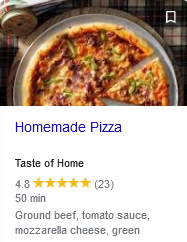
Videos – These video results appeared midway down the first page in Google for “how to make pizza”. This first video is dominating the real estate here thanks to its timeline. As I covered in my SEO for YouTube guide, it’s important to add timestamps to create a timeline for more easily navigating the video.
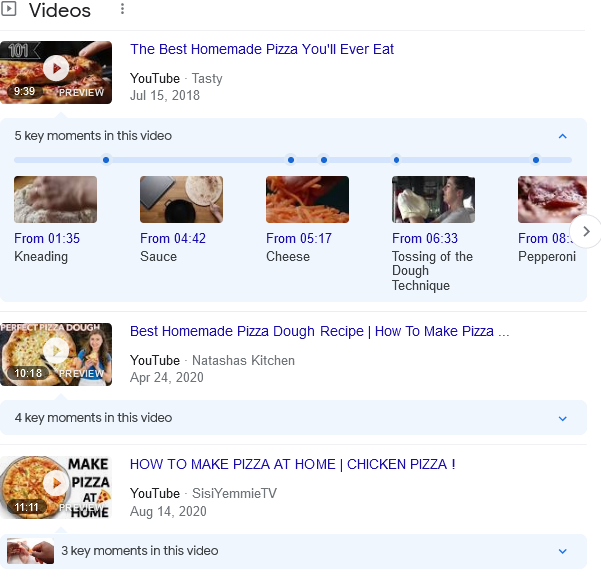
Event – You can get more detailed information on upcoming events. Doing a simple search for “Coldplay tour” showed this rich snippet on Ticketmaster.

Why Use Rich Snippets
Why use rich snippets? In going back to our original example of the pizza shop, outside of the local listings at the top of the page, this was the only listing on page one in the normal listings which featured anything besides a URL, title, and description.
This is an important effect of rich snippets: they help your page stand out. In this case, the yellow stars draw the eye and the positive rating encourages a click. With the Ticketmaster example, we can even get links to relevant deeper pages on our site.
When leveraged properly, we can earn a lot more traffic from rich snippets, and targeted traffic at that. In other words, they raise CTR which again has a direct bearing on your ranking in Google.
And on top of additional relevant information leading to more clicks, simply put the more real estate you can claim in Google the better.
How to Create Rich Snippets in WordPress
Now that you’re sold on them, let’s talk how to create rich snippets in WordPress
First, be sure that your content lends itself to one of the types of rich snippets. While reviews, recipes, and event types (to name a few) are great for some sites, rich snippets aren’t for every site.
Google has a page where you can see the various types of structured data which lead to rich snippets.
You can filter by the type of website you have to see the most relevant types of rich snippets you can get featured. The page even tells you how to add them to your site, so it’s worth checking out as it can vary between types.
The easiest way for how to create rich snippets in WordPress is through a structured data plugin.
For demonstration purposes on how to create rich snippets in WordPress, let’s focus on Schema and Structured Data for WP and AMP.
In this plugin, it’s a one or two step process to add structured data to a page or post/article.
After you’ve installed it, navigate to the plugin in your dashboard and select “Add Schema Type”.
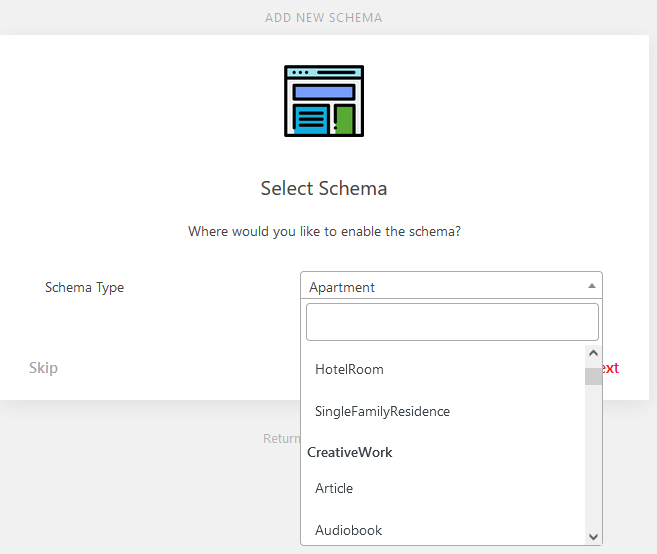
There are dozens of options to choose from here, including the few I mentioned earlier. By choosing a schema type, you’re giving the site access to add this to a specific content type on your site (pages, articles, etc.).
Let’s get practical and think of something basic which even AngrySEOer.com can utilize.
I write articles, so I selected “Article” from the drop-down list. I then applied it to “posts” on my site, which is the WordPress content type I use for these articles.
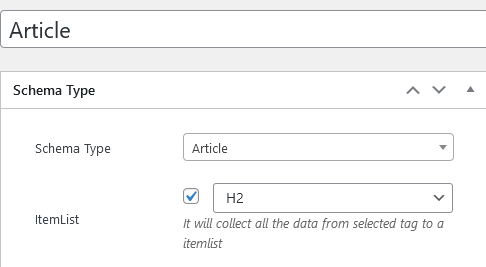
As you can see from the image above, the effect of this schema type is to turn our headings (in our articles/posts) into a list in Google.
We can choose which heading type to apply this to. The effect is something you’ve likely seen on certain searches you’ve done before:
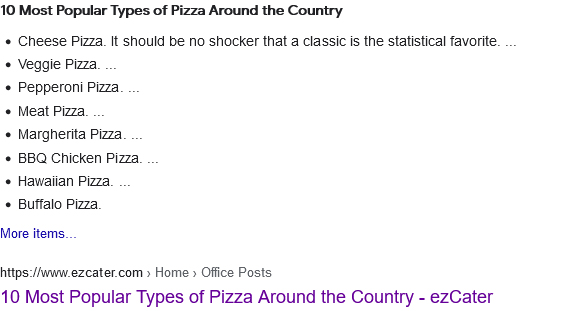
This was the first thing to show in Google when I searched for “types of pizza”. In taking a peak at the code on that page, every type of pizza listed is written with an H2 heading tag.
The page utilizes schema markup like I showed on the plugin to offer Google the ability to show the page’s H2 content as a list in Google.
Now in some instances, the entire list will display in Google if it’s short enough, begging the question why anyone would click on the page at that point.
Thankfully in this case, a couple items on the list are kept out of site. Clicking on “more items” takes you to the page. In this case, it can be used to not only get valuable top-of-Google real estate, but also to entice people to click through for the full list.
Admittedly this is just one particular type of schema. If we have an Ecommerce site, we can pick the type of product we might be selling as the schema type. Some are more specific, depending if there are more specific bits of information related to them.
For instance, there’s a “Video Game” specific option in the plugin to choose.
After applying that to certain types of content (in this case we might create a specific type of content in WordPress for video game sales pages), we can navigate to a specific video game’s page to enter the specific data for that item.
This includes release date, cost, etc.
Then, when someone searches for that game; your page may appear for that search and list additional relevant information for that game which other pages don’t offer. This gives people incentive to click through to your page over others.
That’s just another example to give you an idea of how in depth and the many different applications schema markup and rich snippets can have.
How to Test Rich Snippets
Once you’ve created your structured data, you can test it using a free tool from Google.
Go to https://search.google.com/structured-data/testing-tool where it will prompt you to enter your page’s URL to test. The tool analyzes the code on your page to detect whether or not rich snippets can be displayed in Google.
It will tell you specifically which snippets it may qualify for, as well.
Just like with subheadings (see how to get Google subheadings in search results), it’s not guaranteed that rich results will display with your page.
Even if it passes the test with the tool, displaying them is still subject to Google’s whim at the end of the day. If it would display otherwise, it also won’t if there are too many other better ranking pages with rich snippets featured ahead of yours.
The main takeaway is that rich snippets are absolutely worth your time when used correctly. They benefit some types of sites/niches more than others, but even with the article example, you can see there are applications for most any site.
Most importantly, rich snippets help your page stand out in Google alongside other pages, offers users more detailed information to encourage click-throughs, and they’re very easy to implement in WordPress.

Pingback: The Ultimate SEO Checklist for Blog Posts - Angry SEOer
Pingback: H1 H2 H3 SEO - What's the Deal? - Angry SEOer
Pingback: KeySearch Review - Angry SEOer